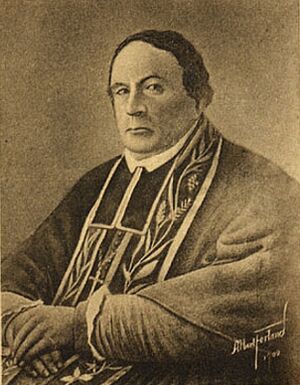Norbert Provencher facts for kids
Quick facts for kids Joseph-Norbert Provencher |
|
|---|---|
| Bishop of Saint-Boniface, Manitoba | |
 |
|
| Archdiocese | Saint Boniface |
| Enthroned | June 4, 1847 |
| Reign ended | June 7, 1853 |
| Predecessor | None |
| Successor | Alexander-Antonine Taché |
| Other posts | Coadjutor Bishop of Quebec City Vicar Apostolic of North-West (Nord-Ouest) |
| Orders | |
| Ordination | December 21, 1811 |
| Personal details | |
| Born | February 12, 1787 Nicolet, Province of Quebec |
| Died | June 7, 1853 (aged 66) Saint Boniface, Rupert's Land |
Joseph-Norbert Provencher (born February 12, 1787 – died June 7, 1853) was an important Canadian church leader and missionary. He helped found the modern province of Manitoba. He became the very first Bishop of Saint Boniface and played a big role in the history of the French-speaking community in Manitoba, known as the Franco-Manitoban people.
Contents
Early Life and Mission
Joseph-Norbert Provencher was born in Nicolet, Quebec, in 1787. His parents, Jean-Baptiste and Élisabeth Proulx Provencher, were farmers. Joseph went to school at Nicolet College and the Quebec Seminary. He became a priest in 1811. For several years, he worked in different church areas.
In 1818, Bishop Joseph-Octave Plessis of Quebec sent Provencher and two other priests on an important mission. They were to go to the Red River area, which is now part of Manitoba. Many settlers there were Irish and Scottish Catholics. Provencher's job was to help the local First Nations and Métis communities. He also cared for European settlers who had moved there. At first, Provencher did not speak English.
Building a New Community
Provencher and his team arrived at Fort Douglas in mid-July. Thomas Douglas, 5th Earl of Selkirk, who was a major owner in the Hudson's Bay Company, gave the missionaries land. This land was on the east bank of the Red River. They quickly started building a house before winter arrived. Part of this building became a chapel. Provencher named this chapel after a famous missionary, Saint Boniface.
The mission at Saint Boniface became very successful. Provencher baptized many local First Nations and Métis people, as well as many European settlers. In 1819, Provencher was given the special title of Auxiliary Bishop of Quebec. This meant he was a helper bishop for the Quebec area and a leader for the church in the northwest. He was officially made a bishop in 1822.
Education and Growth
After returning to Saint Boniface, Provencher continued to build up the community. He built a school that is now known as the Université de Saint-Boniface. In 1832, he built the Saint-Boniface Cathedral. He also started a school in 1838 to teach people how to weave wool. This wool came from sheep that were brought into the area.
Provencher faced challenges as he worked to establish Christian ways of life. Some European settlers did not want to change their customs.
In 1844, Provencher was put in charge of a new church area called the Vicariate Apostolic of James Bay. This area was later made into the Diocese of Northwest in 1847, and he became its first bishop. In 1851, it was renamed the Diocese of Saint Boniface.
Expanding the Mission
In 1843, Provencher traveled to Europe to find more religious men and women to help with the missions. In 1846, two priests from the Missionary Oblates of Mary Immaculate arrived to help. In 1850, Alexandre-Antonin Taché was named a helper bishop to Provencher. He helped set up missions for First Nations people at Lac Sainte-Anne and Saint-Jean Baptiste.
Provencher also brought the Grey Nuns to the Canadian Northwest. In 1860, three Grey Nuns arrived at Saint-Jean Baptiste. They started a school and a hospital, which were very important for the growing community.
Legacy
Bishop Provencher was a tall man, standing six feet four inches. He was known for being moral, humble, determined, and very religious.
He passed away in Saint Boniface, Manitoba, on June 7, 1853, at 66 years old. Today, Provencher Boulevard in Winnipeg is named after him. There is also a monument to him in the Saint Boniface Cathedral Cemetery. His historical papers are kept in the Archives of the Archdiocese of Quebec and the Archives of Manitoba.
See also
- Jean-Baptiste Thibault
- Louis-François Richer Laflèche
Sources
- "Norbert Provencher". Dictionary of Canadian Biography (online). (1979–2016). University of Toronto Press.
- Manitoba Historical Society article
- Catholic Hierarchy article

